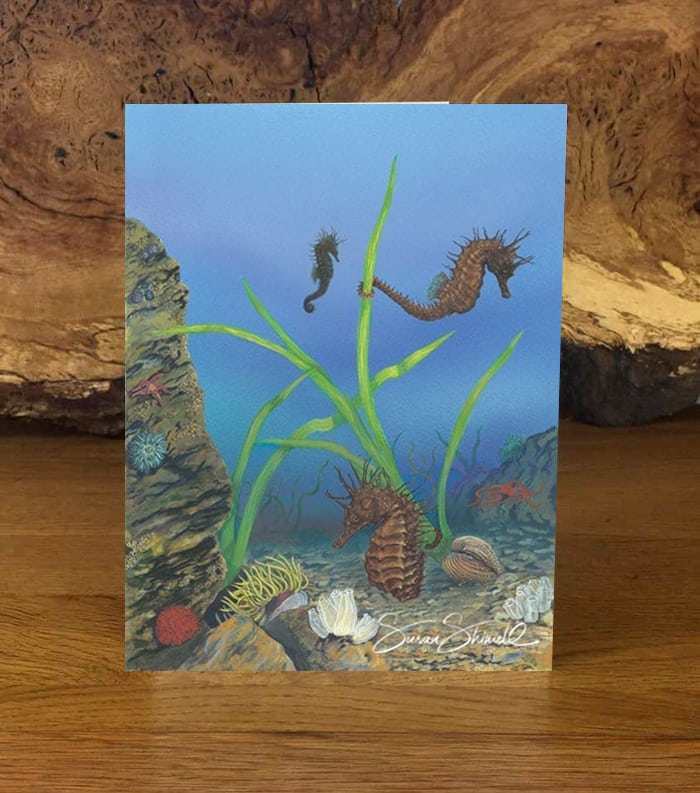Seahorse World
£4.05
Greetings Card (FSC Board)
Size: 175mm x 125mm
Card blank inside
Free P+P
Original Painting Medium: Gouache
Scientific Name: Hippocampus ramulosus
Region: U.K
As children, my sister and I were each given a brooch that consisted of a two-inch-long dried seahorse with a metal clasp glued to one side. I remember looking at the yellowish, dried body stuck to the pin and being both repulsed and intrigued. I had never seen anything like it before and recall thinking that it didn’t look very nice. For the past 60+ years, the brooch has sat at the bottom of my jewellery box.
As I became more aware of conservation and environmental issues, I wondered how many hundreds of thousands of these beautiful, delicate little sea creatures had died – destined to sit and gather dust at the bottom of jewellery boxes, or entombed in plastic keyrings and perspex paperweights.
Whilst at art college we were taken to a local aquarium and given the choice of studying and portraying one of the exhibits. Whilst there I discovered a tank containing a lone seahorse. An accidental by-catch by local fishermen; it had been caught off the Dorset coast.
I feel quite strongly that it is wrong to keep any creature in isolation and captivity, and for this reason wished he could be returned to his natural environment.
For my Seahorse painting, I spent a number of hours observing and sketching the seahorse for my underwater scene.
As seahorses live in shallow waters, my underwater scene includes sea creatures that inhabit the seahorse world: limpets, mussels, acorn barnacles, a brittle star, a prickly cockle, light-bulb sea squirts, beadlet snakelocks, jewel anemones, a featherstar, and a common starfish.
The original artwork was painted in gouache and is framed.
Seahorses:
The name seahorse is derived from the Greek: Hippos (horse) and campus (sea monster). Seahorses occur mainly in the Indo-Pacific and W. Atlantic regions, primarily in mangroves, coral, and seagrass habitats; they are also found only occasionally off the southern and western shores of Great Britain. Their diet consists of fry and small crustaceans, such as brine shrimp which are sucked in through a bony tube-like snout.
Seagrass meadows are internationally important and are considered threatened habitats around the world. They are the home of many species, including seahorses. Seagrass meadows in Studland Bay, Dorset, are unique in the UK as they are known breeding sites for both spiny and short-snouted seahorses. Seagrass meadows are under threat from boat anchors and chains which can dislodge and break up the seagrass root system. Studland is one of the most popular anchorages in the south with up to 300 boats visiting each day during the summer months.
Swimming in an upright position seahorses use their dorsal fin for propulsion and ear-like pectoral fins for stabilisation and steering. They use a prehensile tail to cling to a favourite piece of eelgrass or coral on the sea bed. Seahorses also have long-term faithful pair bonds and if a mate disappears they are slow to seek a new partner. The only time during the day that the seahorse is particularly lively is at dawn when partners come together in a greeting dance.
Due to a combination of direct catch, incidental by-catch in trawl nets, pollution, and the destruction of habitat, the seahorse population has declined by fifty percent over the past five years. Forty-five nations trade in seahorses and in 1995 alone, 20 million seahorses, (more than 56 tons), were caught for the Chinese medicinal trade, aquariums, souvenirs, and curios.
